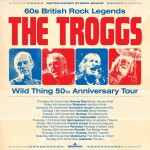What Made Robert Palmer A Unique Figure In 1980s Music?
Robert Palmer, a name synonymous with the eclectic blend of rock, pop and blue-eyed soul, continues to influence the music scene long after his prime. A trailblazer of his time, he was never afraid to experiment and evolve as an artist. Today, we celebrate him as an artist and the lasting impact he has had on the music industry.
At Jukebox Saturday Night, we’re looking at the past and future of R’n’R Heaven.
We delve into stories from the past, such as ‘What happened to The Beatles?’ and ‘What made Robert Palmer stand out from his contemporaries?’ We also check up on legends today to answer questions like ‘How old is Pat Benatar now?’ Our aim remains steadfast: to keep the fire of classic rock music burning bright.
Distinctive style
Fashion icon
When you think of an ‘80s rockstar, you see someone like David Bowie with his androgynous glam appearance, Kurt Cobain with his grungy style or Mötley Crüe with their heavy metal look.
Not Robert Palmer. He was always looking sharp in Italian suits that seemed to flow effortlessly with his smooth vocals. His polished look contrasted starkly with the casual and often rebellious styles that dominated the music scenes of the time. This fondness for suave, sophisticated looks made him stand out, not just as a musician but as a style icon.
MTV era influence
Robert Palmer videos made a huge visual impact during the MTV boom. His music video for ‘Addicted to love’ became a cultural phenomenon, featuring sharply dressed, stoic models as band members. This video not only showcased his distinctive style but also set a new standard for music video production.
It was stylish, memorable and slightly provocative, cementing Palmer’s place as a major influence in the music video revolution of the 1980s.
Musical diversity
Genre fusion
Robert Palmer wasn’t one to stay in his lane. The man had a gift for mashing up rock, pop and blues with just about anything that caught his ear. Funk, reggae and even bossa nova snuck into his tracks.
This wild blend not only showed his range but also created a sound that was all Palmer, all the time. His greatest hits album is like a trip to a back alley record shop that has different styles together under one roof, all with Palmer’s signature sense of rhythm.
Signature songs
Palmer’s knack for creating catchy, vibrant tracks was exemplified in his signature songs.
‘Addicted to love’ had that relentless beat and iconic, guitar-cradling models that felt like visual adrenaline. ‘Bad case of loving you’ brought rock ‘n’ roll grit with a side of slick, while ‘Simply irresistible’ was pure pop candy.
These Robert Palmer songs not only rocked the charts but also defined the decade, with Palmer’s polished vocals and sharp production making each track a classic in its day.
Collaborative ventures
The Power Station
Aside from his solo work, Palmer was a pivotal part of The Power Station, a supergroup that mashed up Robert Palmer with band members John Taylor and Andy Taylor, who played the bass and guitar of Duran Duran, and Chic drummer Tony Thompson.
This wasn’t your typical band side project. It was a bold experiment in rock and funk, shaking up the music scene with hits like ‘Some like it hot’ and a punchy cover of T. Rex’s ‘Get it on’. The Power Station showcased Palmer’s ability to bridge worlds, bringing his sleek style to a rawer, more pulsating sound that rocked the mid-‘80s music charts.
Musical partnerships
Palmer thrived on variety, and his collaborations read like a who’s who of the music world. From Little Feat’s funky beats to the gospel-infused vocals of Vinegar Joe, Palmer’s collabs were as eclectic as his music library.
His willingness to take on a new music style and influences each time allowed Palmer to explore new territories in sound and style, cementing his reputation as a musician who could adapt and innovate with the best in the business.
Frequently Asked Questions (FAQ)
What genre of music was Robert Palmer known for?
Robert Palmer music was never about sticking to one style. He was a master of genre-blending, constantly experimenting with sounds from rock, pop, blues, soul, reggae and more. Palmer thrived on the thrill of mixing it up, bringing everything from funk grooves to jazzy undertones into the mix.
What were Robert Palmer’s biggest hits?
The Robert Palmer discography is studded with massive hits that defined much of the 1980s soundscape. Tracks like ‘Addicted to love’ with its driving beat and iconic music video and ‘Simply irresistible’, where his sharp lyrics met even sharper suits, became anthems of an era. And who can forget the raw energy of ‘Bad case of loving you’?
What legacy did Robert Palmer leave behind in the music industry?
Robert Palmer is remembered as a stylish pioneer who dared to mix musical elements like a mad scientist. His influence lingers in the airwaves, inspiring artists who dare to blend genres and break moulds. His legacy is evident in every modern artist who values the fusion of style and substance in music – proof that authenticity can coexist with mainstream appeal.
Music never goes out of style
From its humble beginnings with a group of music-loving friends, Jukebox Saturday Night has evolved, drawing in a dedicated fan base that thrives on nostalgia and the thrill of classic tunes. Our platform not only revisits the golden era of rock but also ensures that the essence of these timeless genres continues to resonate with audiences new and old.
We want to make sure that legends like the Little River Band members and icons of yesteryear maintain their rightful place in the hearts of fans across generations.
We explore connections and content around the web to make music history more accessible to our audience. We also honour other significant figures such as Mike Smith (Dave Clark Five) and Robert Palmer, ensuring their contributions are recognised. Discover more about your favourite artists right here!
Disclaimer: The information provided is for educational and entertainment purposes only. While we strive for accuracy, music history is often based on available documentation and interpretation.



